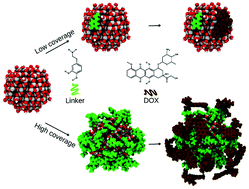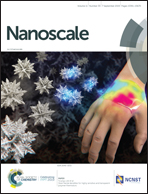Rational design of nanosystems for simultaneous drug delivery and photodynamic therapy by quantum mechanical modeling†
Abstract
Drug delivery systems are based on reversible interactions between carriers and drugs. Spacers are often introduced to tailor the type of interaction and to keep drugs intact. Here, we model a drug delivery system based on a functionalized curved TiO2 nanoparticle of realistic size (700 atoms – 2.2 nm) by the neurotransmitter dopamine to carry the anticancer chemotherapeutic agent doxorubicin (DOX). The multiscale quantum chemical study aims at unraveling the nature and mechanism of the interactions between the components and the electronic properties of the composite system. We simulate the temperature effect through molecular dynamics runs of thermal annealing. Dopamine binds preferentially to low coordinated Ti sites on the nanoparticle through dissociated bidentate and chelate modes involving the diol groups. DOX is tethered by H-bonds, π–π stacking, dipole–dipole interactions and dispersion forces. Comparing different coverage densities of the spacer on the nanoparticle surface, we assess the best conditions for an effective drug transport and release: only at full coverage, DOX does not slip among the dopamine molecules to reach the nanoparticle surface, which is crucial to avoid the formation of stable coordinative bonds with under-coordinated Ti atoms. Finally, given the strong absorption properties and fluorescence of DOX and of the TiO2 photocatalyst, we model the effect of light irradiation through excited state calculations to localize excitons and to follow the charge carrier's life path. This fundamental study on the nature and mechanism of drug/carrier interaction provides a solid ground for the rational design of new experimental protocols for a more efficient drug transport and release and its combination with photodynamic therapy.



 Please wait while we load your content...
Please wait while we load your content...